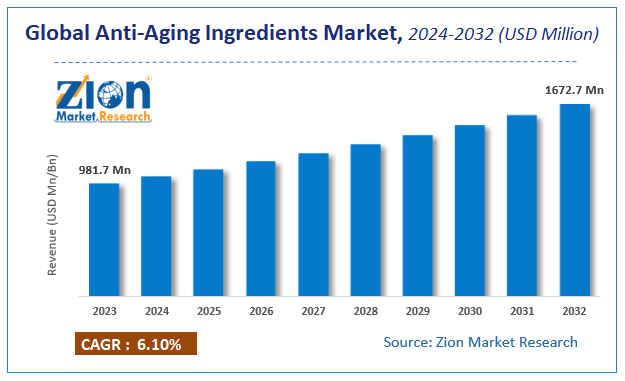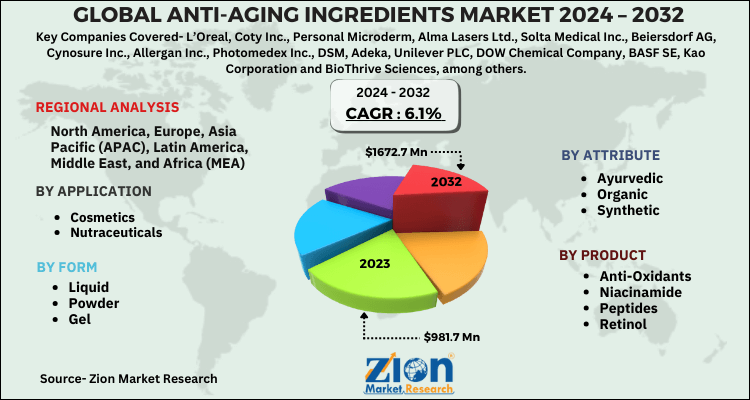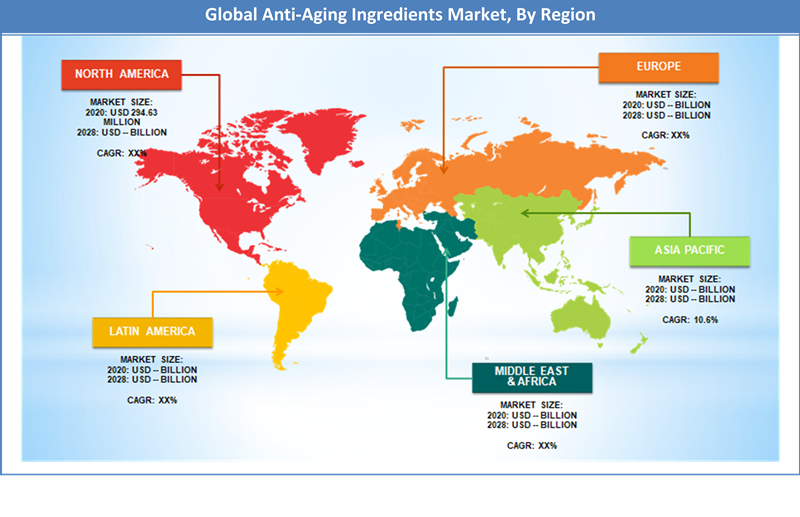Anti-Aging Ingredients Market Size, Share, Trends, Growth 2032

Anti-Aging Ingredients Market By Form (Liquid, Powder, and Gel), By Application (Cosmetics, Nutraceuticals), By Attribute (Ayurvedic, Organic, and Synthetic), By Product (Anti-Oxidants, Niacinamide, Peptides, and Retinol): Global Industry Perspective, Comprehensive Analysis and Forecast, 2024 - 2032-
| Market Size in 2023 | Market Forecast in 2032 | CAGR (in %) | Base Year |
|---|---|---|---|
| USD 981.7 Million | USD 1672.7 Million | 6.1% | 2023 |
Anti-Aging Ingredients Market Insights
According to a report from Zion Market Research, the global Anti-Aging Ingredients Market was valued at USD 981.7 Million in 2023 and is projected to hit USD 1672.7 Million by 2032, with a compound annual growth rate (CAGR) of 6.1% during the forecast period 2024-2032. This report explores market strengths, weakness, opportunities, and threats. It also provides valuable insights into the market's growth drivers, challenges, and the future prospects that may emerge in the Anti-Aging Ingredients Market industry over the next decade.
Global Anti-Aging Ingredients Market: Overview
Anti-aging is to stop or delay the process of aging. The Anti-aging ingredients make the skin appear smoother, younger and radiant, diminishing the deep lines and wrinkles. Retinoids, coenzyme Q10, antioxidants, vitamin C, sunscreen, and peptides are some of the anti-aging ingredients that have been used in conventional moisturizing creams. The market is primarily driven by increasing awareness among people for personal care, where these anti-aging ingredients mainly help to maintain the tone and texture of their skin. There has been a rising demand for natural skin-care products which contain fruits and vegetables contents instead of artificial contents. Also, nowadays, anti-aging ingredients manufacturers are introducing safer and more effective anti-aging products providing instant results.
COVID-19 Impact Analysis
The outbreak of COVID-19 will impact both demand and supply. It will not decrease demand or supply, but lockdown have impacted transportation, which resulted in disruption of the supply and demand chain. Due to the growing awareness regarding personal care, changing lifestyles, and increasing purchasing power, this market is predicted to grow in the coming years. Also, there has been a postponement of several non-essential and elective anti-aging surgical procedures, which has negatively impacted the growth of the market.
Anti-Aging Ingredients Market: Growth Factors
Anti-Aging Ingredients help in improving the skin by temporarily plumping the skin, making wrinkles and lines less visible. These ingredients contain antioxidants, which help to hydrate the skin. The growing awareness regarding personal care, the proven potential of these ingredients to improve skin tone and textures and the growing elderly population have been the main drivers for the demand for Anti-aging Ingredients.
Further, due to advancements in technology and huge investments in research and development have led to the development of new anti-aging ingredients. Strict rules and regulations have made the manufacturers to produce safer and more effective products which provide quick results, thus widening the growth prospects of the overall Anti-Aging Ingredients market. The surprising benefits and availability of these ingredients at affordable prices are also factors for the rising demand for Anti-Aging Ingredients.
Form Segment Analysis Review
When it comes to form, the Anti-Aging Ingredients are divided into three types of liquid, powder and gel. Due to the longer shelf lives and usage of fewer preservatives, powder form is much preferred by consumers, although there is significant demand for liquid-form products. When it comes to liquid-based anti-aging ingredients, there are companies that focus on introducing the skin care product in the liquid form for all the types of skins such as Normal/Oily skin, Normal/Dry skin and Normal/Extra Dry Skin. The L’Oréal Paris Hydra Genius Daily Liquid Care is one of the products by L’Oréal which has introduced the three different water-based moisturizers for different types of skin.
Application Segment Analysis Preview
Based on the application, the anti-aging market is divided into cosmetics and nutraceutical. The increasing demand for anti-aging products and acne removal solutions along with the increase in demand for men grooming products will shape the industry growth. Nutraceutical ingredients have shown huge potential in anti-aging effect by delaying the degradation of skin cells. These ingredients have prevented in skin roughness, wrinkling and skin elasticity. Some of the most commonly used nutraceutical ingredients are carotenoids, amino acids, minerals and polyphenols.
Attribute Segment Analysis Preview
The Ayurvedic attribute segment holds a major share among the attributes such as Ayurvedic, organic and synthetic segments. The association of Ayurveda in cosmetics has been gaining significant importance in the health, beauty and wellness sector. Based on the established knowledge of Ayurveda, fruit extracts and herbal extracts are now being effectively used in medicines and personal care. Also, consumers have been demanding organic products, produced out of naturally obtainable elements, in an effort to adopt a healthy lifestyle. While chemically manufactured products show immediate effects, natural organic products are also largely preferred by consumers due to their ability of no-side effects. Some of the preferred products include olive oil, grape seed, turmeric, jojoba oil, sunflower seeds and berries.
Product Segment Analysis Preview
Antioxidants help the skin from sun rays damage and wrinkles by combatting the elements that harm the DNA of skin cells. When it comes to Anti-Aging Ingredients, retinols are widely researched anti-aging ingredients available. As they are the vitamin A derivatives, they are often touted as gold standard for reducing wrinkles, fine lines and large pores. Collagen is necessary to maintain strong and youth-looking skin. Retinols, not only, preserve the collagen stores in the bodies, but also help in new collage production.
Anti-Aging Ingredients Market: Report Scope
| Report Attributes | Report Details |
|---|---|
| Report Name | Anti-Aging Ingredients Market |
| Market Size in 2023 | USD 981.7 Million |
| Market Forecast in 2032 | USD 1672.7 Million |
| Growth Rate | CAGR of 6.1% |
| Number of Pages | 125 |
| Key Companies Covered | L’Oreal, Coty Inc., Personal Microderm, Alma Lasers Ltd., Solta Medical Inc., Beiersdorf AG, Cynosure Inc., Allergan Inc., Photomedex Inc., DSM, Adeka, Unilever PLC, DOW Chemical Company, BASF SE, Kao Corporation and BioThrive Sciences, among others |
| Segments Covered | By Form, By Application, By Attribute, By Product, and By Region |
| Regions Covered | North America, Europe, Asia Pacific (APAC), Latin America, Middle East, and Africa (MEA) |
| Base Year | 2023 |
| Historical Year | 2018 to 2022 |
| Forecast Year | 2024 - 2032 |
| Customization Scope | Avail customized purchase options to meet your exact research needs. Request For Customization |
Anti-Aging Ingredients Market: Regional Analysis Preview
North America accounted for a share of around 39% in 2020. The increasing demand for skincare products, rising awareness among people and product availability at salons, spas, online stores and retail outlets have been the major contributing factors for such high demand here.
Asia Pacific is projected to grow at a CAGR of over 10.6% during the forecast period. In the Asia-Pacific region, China accounted for the highest share of anti-aging market due to the factors such as elderly growing population and growing awareness of beauty therapies. Also, there has been increasing demand in Japan due to increasing research and development activities, adoption of modern lifestyle and the launch of the new products such as creams and serums.
Anti-Aging Ingredients Market Players & Competitive Landscape
Some of key players in anti-aging ingredients market are
- L’Oreal
- Coty Inc.
- Personal Microderm
- Alma Lasers Ltd.
- Solta Medical Inc.
- Beiersdorf AG
- Cynosure Inc.
- Allergan Inc.
- Photomedex Inc.
- DSM
- Adeka
- Unilever PLC
- DOW Chemical Company
- BASF SE
- Kao Corporation and BioThrive Sciences
The global Anti-Aging ingredients market is segmented as follows:
By Form
- Liquid
- Powder
- Gel
By Application
- Cosmetics
- Nutraceuticals
By Attribute
- Ayurvedic
- Organic
- Synthetic
By Product
- Anti-Oxidants
- Niacinamide
- Peptides
- Retinol
By Region
- North America
- The U.S.
- Canada
- Europe
- France
- The UK
- Spain
- Germany
- Italy
- Rest of Europe
- Asia Pacific
- China
- Japan
- India
- South Korea
- Southeast Asia
- Rest of Asia Pacific
- Latin America
- Brazil
- Mexico
- Rest of Latin America
- Middle East & Africa
- GCC
- South Africa
- Rest of Middle East & Africa
Table Of Content
Methodology
FrequentlyAsked Questions
According to a report from Zion Market Research, the global Anti-Aging Ingredients Market was valued at USD 981.7 Million in 2023 and is projected to hit USD 1672.7 Million by 2032.
According to a report from Zion Market Research, the global Anti-Aging Ingredients Market a compound annual growth rate (CAGR) of 6.1% during the forecast period 2024-2032.
Some of the key factors driving the global Anti-Aging market growth are increasing awareness about personal care, proven benefits and investments in research and development to bring new products in the market.
North America region held a substantial share of the global Anti-Aging market in 2020. Investments in research and development also contributes to increasing share here. Asia Pacific region is projected to grow at a significant rate owing to reasons such as growing elderly population in China and increasing usage of technological advancements in Japan.
Some of key players in anti-aging ingredients market are L’Oreal, Coty Inc., Personal Microderm, Alma Lasers Ltd., Solta Medical Inc., Beiersdorf AG, Cynosure Inc., Allergan Inc., Photomedex Inc., DSM, Adeka, Unilever PLC, DOW Chemical Company, BASF SE, Kao Corporation and BioThrive Sciences, among others.
List of Contents
Market InsightsOverviewGrowth FactorsForm Segment Analysis ReviewApplication Segment Analysis PreviewAttribute Segment Analysis PreviewProduct Segment Analysis PreviewReport ScopeRegional Analysis PreviewMarket Players Competitive LandscapeThe global Anti-Aging ingredients market is segmented as follows:RelatedNews
HappyClients
Zion Market Research
Tel: +1 (302) 444-0166
USA/Canada Toll Free No.+1 (855) 465-4651
3rd Floor,
Mrunal Paradise, Opp Maharaja Hotel,
Pimple Gurav, Pune 411061,
Maharashtra, India
Phone No +91 7768 006 007, +91 7768 006 008
US OFFICE NO +1 (302) 444-0166
US/CAN TOLL FREE +1 (855) 465-4651
Email: sales@zionmarketresearch.com
We have secured system to process your transaction.
Our support available to help you 24 hours a day, five days a week.
Monday - Friday: 9AM - 6PM
Saturday - Sunday: Closed







